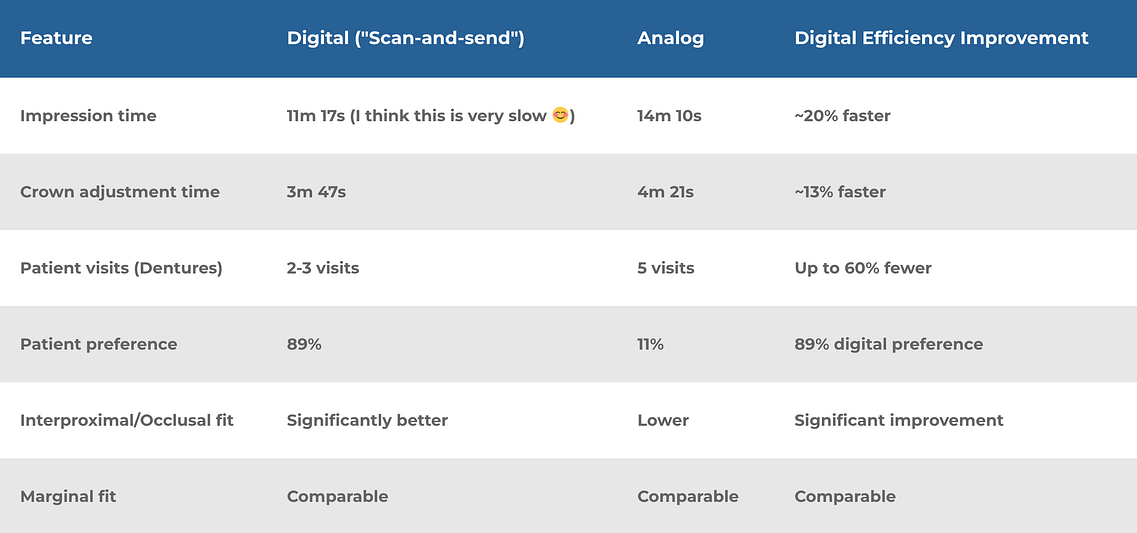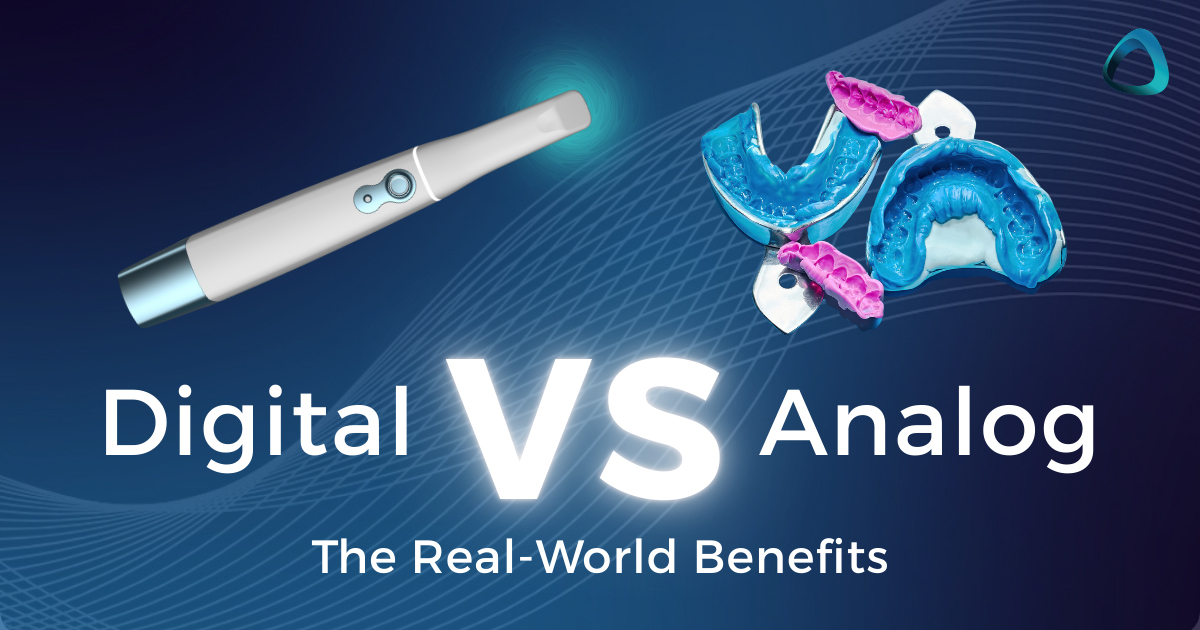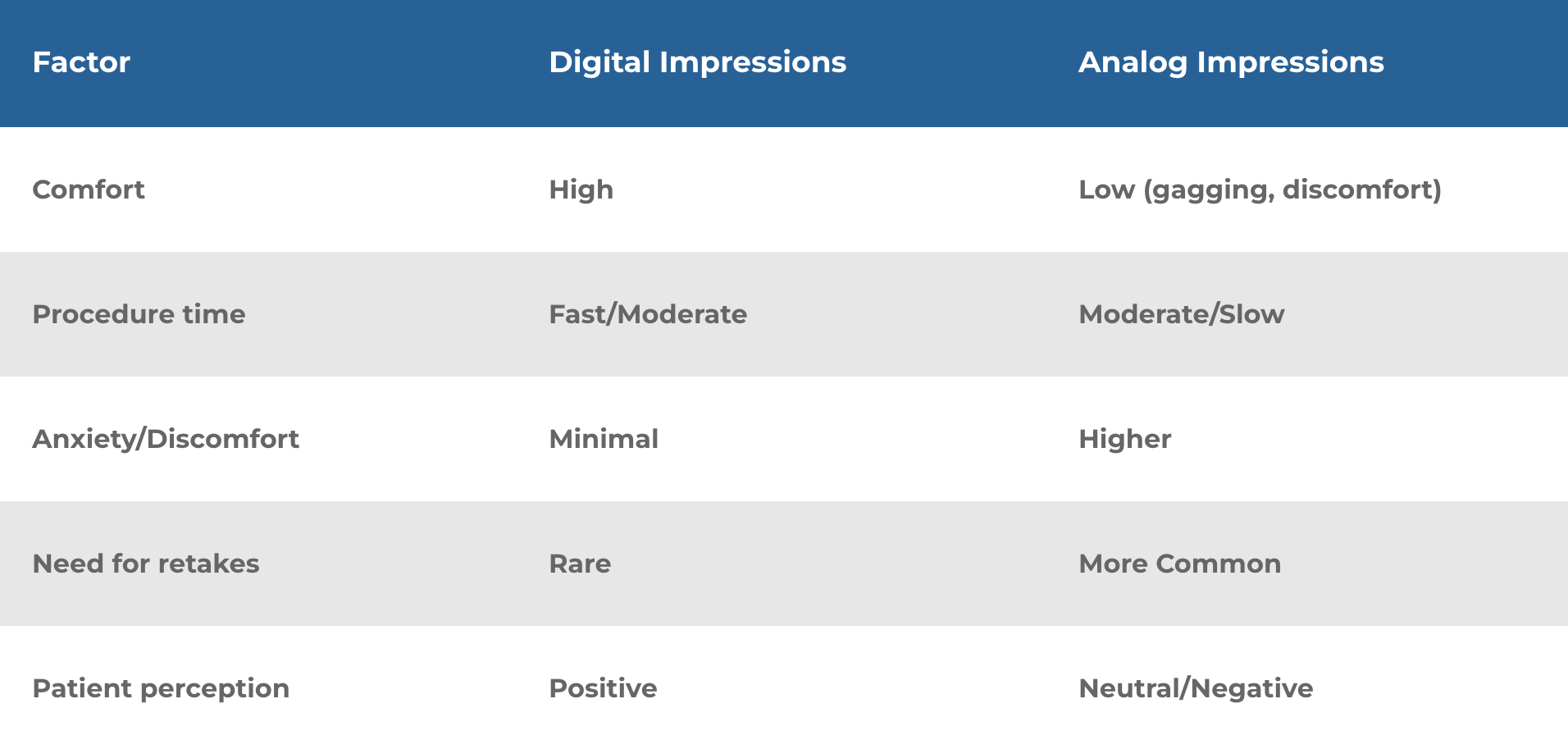The dental profession is experiencing a digital revolution, but the pace of adoption reveals an industry in transition.
While approximately 53% of U.S. dentists now use intraoral scanners¹, only 17% have integrated 3D printers into their workflows², and even fewer have milling machines in their offices. USA leads so these figures would be the upper limit of digital adoption globally, with other countries most likely showing lower rates of adoption.
The adoption discrepancy raises critical questions: Are these technologies merely expensive gadgets for early adopters, or do they represent a real fundamental shift in how dentistry should be practiced? What's driving some practices to invest while others hold back?
For those already using digital tools, the benefits are clear. 70% cite improved clinical efficiency as their primary motivation, with 90% employing intraoral scanners for single tooth-supported crowns¹. Meanwhile, the Digital Smile Design software market is projected to nearly double from $151.1 million in 2025 to $281.8 million by 2033⁴, reflecting growing demand for personalized, aesthetic-focused care.
There is also little doubt that patients prefer single-visit dentistry to multiple visits, and many reports have confirmed this. 2/3 of patients report that they would change dentist for a same-day crown.
This isn't about following trends or acquiring the latest gadgets. It's about examining the measurable differences between digital and analog workflows to determine if and where digital dentistry offers genuine advantages for practitioners and patients alike.
Let's get into it.
Current Adoption Rates of Digital Dental Technology

Technology | Current Adoption (USA) | Growth Trajectory | Primary Applications |
|---|---|---|---|
Intraoral Scanners | 40-53% of dental offices | 58% adopted within the last 4 years | Digital impression for single-unit crowns (90%) |
3D Printers | 17% of dental offices | 67% adopted in the last 2 years | Surgical guides, splints, models, temporaries |
CBCT Scanners | 66.7% of specialists, 24% of general dentists | 8.6% annual market growth | Implant planning, endodontics, orthodontics |
CAD/CAM Milling | Widespread (90% +) in labs, Growing in practices | 9.2% annual market growth | Same-day restorations, full-contour crowns, bridges |
AI Diagnostic Tools | Early clinical adoption (~5%) | 22.3% annual market growth (fastest-growing segment) | Caries detection, periodontal assessment, treatment planning |
Digital Smile Design | Growing in cosmetic practices | Market expected to double by 2033 | Aesthetic case planning, patient communication, wax-ups |
Note: Market growth figures represent compound annual growth rate (CAGR)
The adoption patterns reveal a digital transformation led by specialists and larger practices, with precision-enhancing technologies seeing the fastest uptake. AI diagnostic tools are experiencing the most rapid growth at 22.3% annually, while integrated workflows combining multiple technologies (such as CBCT with CAD/CAM) represent the frontier of comprehensive digital dentistry.
The Numbers Don't Lie: Efficiency and Time Savings
The efficiency differences are immediately apparent when one walks through modern digital practice.
Research consistently demonstrates significant time savings across various procedures when implementing digital workflows:
- Single-Unit Restorations: Digital workflows reduce active working time by 38.4% compared to analog methods.¹
- Total treatment time: Digital techniques cut treatment time by an average of 60.36%.²
- Lab Turnaround: Digital workflows can reduce waiting time from two weeks to as little as a few days for restorations, representing a 75-85% reduction.³
These efficiency gains translate directly to more patients seen, reduced chair time per procedure, and improved practice productivity.
Time and Efficiency Comparison
Workflow Area | Digital Benefit VS Analog |
|---|---|
Active working time (single-unit) | 38.4% reduction¹ |
Bite registration time | 60.4% reduction² |
Lab turnaround time | 75-85% faster³ |
Dental lab cost savings | 70-80% per part⁴ |
Labor cost reduction | Up to 30%⁵ |
Workflow capacity increase | Up to 50%⁵ |
Time Efficiency Comparison Between Digital And Analog Workflows
Here at iDD, we developed this infographic diagram to illustrate the time differences between all the potential digital and analog dentistry workflow pathways for a restoration scenario.
It highlights the potential time-saving benefits of digital technology, depending on the chosen path, from a simple 'scan-and-send' approach, utilizing digital impressions, to a complete in-house end-to-end digital workflow.
Let's face it - adopting a scanner is a good start, but you really don't make a ton of ROI from this.
The real ROI is from in-house production of some form, even for basic indications only.

Click the image above to view it full size.
Cost-Effectiveness: Beyond the Initial Investment
The economics of digital dentistry extend far beyond the initial technology investment. I've seen practices and labs transform their financial outlook once they move past the startup phase of digital integration.
Dental Lab Productivity: Digital design and manufacturing increase technician productivity while reducing hands-on work. Cost savings per part can exceed 70-80% for models, splints, and dentures, largely due to streamlined production and fewer remakes.⁴
Labor Cost Reductions: Automation and digitalization can reduce labor costs in traditional dental labs by up to 30%⁵
Overall Workflow Capacity: Digital solutions can free up as much as 50% of workflow capacity, allowing practices to handle more cases in the same amount of time⁵
When evaluating return on investment, it's essential to consider not just the upfront costs of equipment but the ongoing savings in materials, labor, and increased productivity.
The Patient Experience: Comfort and Preference
Perhaps the most compelling argument for digital dentistry comes from patients themselves.
The data here is particularly striking:
Overwhelming Preference: 89% of patients prefer digital impressions over traditional analog impressions, with only 11% favoring conventional methods.⁶
Reduced Discomfort: Digital impressions eliminate messy materials, uncomfortable trays, and gagging - key factors driving patient preference.⁷
Fewer Appointments: Digital denture workflows can reduce clinic visits from 5 (analog) to just 2-3 visits, a 60% reduction.⁸
Fewer Retakes: Digital systems allow for instant evaluation of scan quality, reducing the likelihood of needing to repeat the impression process.⁹
These improvements in patient experience aren't merely conveniences - they directly impact treatment acceptance, patient retention, and practice reputation.
Patient Preference Drivers
Factor | Digital Impressions | Analog Impressions |
|---|---|---|
Comfort | High | Low (gagging, discomfort) |
Procedure time | Fast/Moderate | Moderate/Slow |
Anxiety/Discomfort | Minimal | Higher |
Need for retakes | Rare | More Common |
Patient perception | Positive | Neutral/Negative |
Accuracy and Precision: Clinical Outcomes
The clinical advantages of digital workflows are measurable and significant. We are no longer in an age of comparing scanners to impression material. It is not 2016 anymore; scanners are obviously better than impressions for most indications.
Here are some interesting research based facts:
- Improved Contact and Fit Quality: Digital methods demonstrate significantly better interproximal and occlusal contact compared to analog techniques¹⁰
- Higher Success Rate: 53.3% of final restorations chosen for placement were from digital impressions, compared to 46.7% from analog impressions⁶
- Comparable Marginal Fit: While digital techniques excel in many areas, studies show similar marginal fit between digital and analog methods, indicating that digital techniques don't compromise on this critical aspect¹⁰
In fact, scans are so much better than impressions that some labs no longer accept physical molds and even give scanners to their clients, who are still dragging their feet on digital adoption.
Digital VS Analog Impression Comparison - what literature shows.

Feature | Digital ("Scan-and-send") | Analog | Digital Efficiency Improvement |
|---|---|---|---|
Impression time | 11m 17s (I think this is very slow | 14m 10s | ~20% faster |
Crown adjustment time | 3m 47s | 4m 21s | ~13% faster |
Patient visits (Dentures) | 2-3 visits | 5 visits | Up to 60% fewer |
Patient preference | 89% | 11% | 89% digital preference |
Interproximal/Occlusal fit | Significantly better | Lower | Significant improvement |
Marginal fit | Comparable | Comparable | Comparable |
Practical Applications: Where Digital Excels
Digital workflows offer particular advantages in specific dental procedures:
Same-Day Dentistry
The ability to scan, design, and mill/print restorations in a single appointment transforms the patient experience while improving practice efficiency. What once required multiple visits can now often be completed in a single session and often with a single injection of local anesthetic.
Diagnostic Models and Treatment Planning
Digital scanning paired with treatment planning software allows for more precise diagnostics and predictable outcomes. Clinicians can visualize, simulate, and plan treatments with unprecedented detail.
Surgical Guides and Implantology
Digital implantology significantly improves precision and predictability. The ability to plan implant placement virtually and then execute that plan with guided surgery reduces risk and improves outcomes. Research is proven time and time again.
Clear Aligners and Orthodontics
The digital workflow has revolutionized orthodontics, enabling more efficient and precise treatment planning, better patient communication, and more predictable results.
The Hybrid Reality: Digital and Analog Working Together
It's worth noting that adopting digital dentistry isn't an all-or-nothing proposition.
Many successful practices implement hybrid approaches where digital and analog techniques complement each other. As Dr. Michael Scherer notes, "I'm a better digital dentist because of my analog mindset."¹¹
Certain procedures and situations may still benefit from traditional approaches, particularly in complex cases or when working with certain materials.
The key is knowing when and where each approach delivers optimal results. One thing that comes to mind is taking scans of an edentulous ridge vs a mucostatic impression - but that really is the only time I may pick up impression material.
Understanding the Investment: Equipment, Time, and Training
The transition to digital dentistry requires thoughtful investment in three key areas:
Equipment: Intraoral scanners, CAD/CAM systems, 3D printers, and milling machines represent significant capital investments
Time: While digital workflows ultimately save time, the initial implementation period requires patience as teams learn new systems.
Training: Perhaps most critical is the investment in proper training and education to maximize the potential of digital technologies
This last point cannot be overstated.
The most sophisticated equipment delivers limited value without the knowledge to use it effectively. Digital technology is merely a tool - its true potential is realized through the skilled hands and minds of well-trained practitioners.
The Critical Importance of Proper Education
The gap between purchasing digital equipment and achieving its full potential lies in education.
Many practices invest in expensive technology only to utilize a fraction of its capabilities due to inadequate training. This represents both a financial and an opportunity cost.
Comprehensive education is essential for:
- Mastering technical aspects of equipment operation
- Understanding the full range of clinical applications
- Implementing efficient workflows that maximize time savings
- Troubleshooting common issues independently
- Staying current with evolving capabilities and updates
Here at the Institute of Digital Dentistry, we stand at the forefront of digital dental education, providing comprehensive, accessible training that transforms technology investments into practical skills and realized gains.
With courses ranging from introductory fundamentals to advanced applications, the iDD platform offers dental professionals and DSOs worldwide the opportunity to master digital workflows at any entry level and upskill to fully take advantage of the digital revolution.
Conclusion - The Evidence-Based Case for Digital Dentistry
The data is clear: digital dentistry offers quantifiable benefits in efficiency, cost-effectiveness, patient experience, and clinical outcomes. The question for most practices and DSOs is no longer whether to adopt digital workflows but how to implement them quickly and effectively.
The transition to digital dentistry flourishes when practitioners invest in equipment and the knowledge to maximize its potential. Practices achieving the greatest success combine cutting-edge technology with comprehensive education, allowing them to implement efficient workflows and unlock the full capabilities of their digital tools. This knowledge-centered approach transforms ordinary digital adoption into extraordinary clinical outcomes and practice growth.
For practices looking to navigate this transition successfully, investing in comprehensive education through established leaders like the Institute of Digital Dentistry provides the quickest and most reliable path to realizing the full potential of digital workflows and the significant returns they offer to both practitioners and patients.


 )
)





Спасибо большое за сообщение. Конечно преимущества цифровой технологии очевидно. Единственный недостаток нужны инвестиции.
Спасибо за ответ! Полностью согласен преимущества цифровых технологий трудно переоценить. А инвестиции, хотя и необходимы, в большинстве случаев быстро себя оправдывают благодаря эффективности и качеству, которые они приносят. Будет интересно обсудить, как можно оптимизировать этот переход.
I am writing a review about the digital dentistry. It is a good reference. Thanks.
I am glad you found it useful 🙂